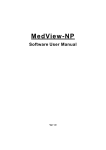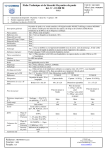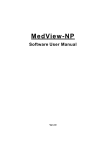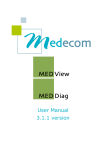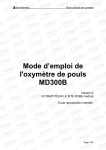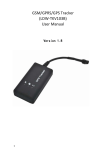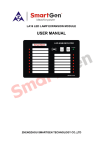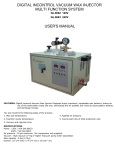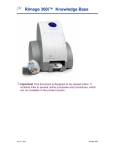Download Medview Software User Manual Ver 4.0 for
Transcript
MedView Software User Manual Ver 4.0 Software Version: 2.1.1 MedView Software user manual Version: Ver4.0 Copyright Our company owns all rights of this unpublished work and intends to maintain it as a confidential work. We may also seek to maintain this work as an unpublished copyright. This publication is to be used solely for the purpose of reference or operation of our software system. No part of this work can be disseminated for other purposes. In the event of inadvertent or deliberate publication, we intend to enforce its right to this work under copyright laws as a published work. Those having access to this work may not copy, use, or disclose the information in this work unless expressly authorized by our company. All information contained in this publication is believed to be correct. We shall not be liable for errors contained herein nor for incidental or consequential damages in connection with the furnishing, performance, or use of this material. The information this publication refers to is protected by copyrights or patents and does not convey any license under the patent rights of our company, nor the rights of others. We do not assume any liability arising out of any infringements of patents or other rights of third parties. Content of the manual is subject to change without prior notice. ALL RIGHTS RESERVED © Beijing Choice All trademarks are the property of Beijing Choice, Inc unless otherwise noted. Bluetooth® and the Bluetooth® Logo are registered trademarks of Bluetooth® SIG, Inc. 2 MedView Software user manual Version: Ver4.0 CONTENTS 1. General Description ........................................................................................................................4 2. Software Installation .......................................................................................................................4 2.1 Typical Installation ......................................................................................................................................4 2.2 Manual USB Driver installation ...............................................................................................................8 3. Software Operation .......................................................................................................................10 3.1 Equipment Connection ............................................................................................................................ 10 3.2 Data Transmission .................................................................................................................................... 10 3.3 Manual search for serial port................................................................................................................. 16 3.4 Bluetooth® data transmission .............................................................................................................. 18 3.5 Patient Management ................................................................................................................................. 24 3.5.1 Edit Patient Info ..........................................................................................................................................24 3.5.2 Edit Patient Title .........................................................................................................................................25 3.6 Review data ................................................................................................................................................. 26 3.6.1 Trend ................................................................................................................................................................26 3.6.2 Table .................................................................................................................................................................26 3.6.3 Analysis ..........................................................................................................................................................27 3.7 Options ......................................................................................................................................................... 28 3.7.1 Roll Step .........................................................................................................................................................28 3.7.2 Analysis Setup ............................................................................................................................................28 3.7.3 Unit Setup ......................................................................................................................................................29 3.8 Save Data ..................................................................................................................................................... 30 3.9 Open Other ID Data or Saved Data ....................................................................................................... 30 3.10 Print ............................................................................................................................................................. 31 3.11 About(A) ..................................................................................................................................................... 31 4. Software uninstall..........................................................................................................................32 3 MedView Software user manual Version: Ver4.0 1. General Description The MedView software is a data management software which applies to Pulse Oximeter series products, including MD300B, MD300K1, MD300I1, MD300W1, MD300C318 and MD2000A. A entire system consists of one pulse oximeter,one computer, a piece of software CD, and a data cable. The waveforms and data saved in the Oximeter can be uploaded to a computer through the data cable and managed by this software. The software is convenient for users to view records, manage and save data including waveform, heart rate and analysis result. It provides the function of printing under patient administration and various modes. Patient administration distinguish datum from their ID which ranges from 1 to 127. So it could save 127 patients’ data at most. The records for the same ID will be regarded as the same patient’s measurement. The ID number in “Patient Info” is the ID number in the corresponding pulse oximeter, and it can not be changed. Notes: Read the manual carefully before running the software! Please make sure that there is at least one record saved in the Pulse Oximeter before data upload. Power up the Pluse oximeter and set the mode of Oximeter to data transmission. 2. Software Installation The software installation includes USB Driver installation and MedView Setup. There are two manners of software installation, one is typical installation which is automatical and the other is manual installation. In the event that the typical installation (USB Driver installation) is unsuccessful, the manual USB Driver installation will be suggested. 2.1 Typical Installation 2.1.1 Put the attached installation CD into computer’s CD driver, the CD will run automatically and then the following interface will appear,as shown in Figure 2-1. Figure 2-1 4 MedView Software user manual Version: Ver4.0 2.1.2 Click the icon“Install MedView Software Ver2.1.1” in Figure 2-1, the following interface will appear. First, the USB Driver will be installed. Figure 2-2 2.1.3 Click “Install” button in Figure 2-2,the USB Driver will be installed on the computer automatically. The following interface is available, it indicates that the USB Driver has been installed successfully, as shown in Figure 2-3. Figure 2-3 Note: If it is failed to install the USB Driver, the manual installation is suggested, refers to the section 2.2 in this manual. 5 MedView Software user manual Version: Ver4.0 2.1.4 Click “OK” button in Figure 2-3, then MedView Setup will run. The following interface will appear, as shown in Figure 2-4. Figure 2-4 2.1.5 Click “Next” button in Figure 2-4, then Figure 2-5 will appear. Figure 2-5 6 MedView Software user manual Version: Ver4.0 2.1.6 Click “Yes” button in Figure 2-5, then Figure 2-6 will appear, click “Next” button and the installatin files will be saved in “C:\Program Files\Choice\MedView”. Also, users can click “Browse” button to choose the root for saving the installation files. Figure 2-6 2.1.7 When the MedView Setup finished, the following figure will appear, as shown in Figure 2-7. Figure 2-7 7 MedView Software user manual Version: Ver4.0 2.1.8 Click “Finish”button in Figure 2-7,the shortcut icon will be created on the desktop, as shown in Figure 2-8. The shortcut and Uninstall MedView icons are added into “Start”menu on the desktop, as shown in Figure 2-9. Figure 2-8 Figure 2-9 2.2 Manual USB Driver installation If the USB Driver cannot be installed automatically, the Manual installation is suggested. 2.2.1Click “Browse this CD” icon, the CD folder will be opened, as shown in Figure 2-10. Figure 2-10 2.2.2 Then dblclick the “usbDriver” folder in Figurer 2-10, the following figure will appear, as shown in Figure 2-11. Figure 2-11 8 MedView Software user manual Version: Ver4.0 2.2.3 Dblclick “Setup. exe” icon to run the USB Driver installation program. The following figure will appear, as shown in Figure 2-12. Figure 2-12 2.2.4 Click “Install” button in Figure 2-12, the interface shown in Figure 2-13 is available. That indicats the USB Driver has been installed successfully. Figure 2-13 9 MedView Software user manual Version: Ver4.0 3. Software Operation After installing the MedView software, it is suggested that the data saved in the oximeter should be transmitted to the computer. Then, users can manage the data. 3.1 Equipment Connection Connect the pulse oximeter to the computer’s USB interface port by the data cable before data transmission. 3.2 Data Transmission This software system will search the corresponding serial port automatically by which the pulse oximeter communicates with the computer. If that is failed, the manual search for serial port will be effective, refers to section 3.3. The manual search function applies to data transmission with data cable. 3.2.1 Dblclick the icon “MedView” on the desktop, the following screen will appear, as shown in Figure 3-1. Figure 3-1 3.2.2 Click the “File(F)” icon, then click the “NewDateCapture” in the drop-down menu, as shown in Figure 3-2. Figure 3-2 10 MedView Software user manual Version: Ver4.0 3.2.3 Select the model of the oximeter, such as “MD300W1”, as shown in Figure 3-3. Figure 3-3 3.2.4 Click “Start” button, then a interface will appear as shown in Figure 3-7,it indicates that the data transmission is finished. NOTE: Click “Start” button, if the following interface appears, as shown in Figure 3-4. That indicates the founction should be activated by successful registration. Figure 3-4 Steps of Registration: (1) Click “Extend” button in Figure 3-3, the following interface will appear as shown in Figure 3-5. Click “GetCode” button, to get a device code. Then the device code will appear in the blanks, as shown in Figure 3-6. 11 MedView Software user manual Version: Ver4.0 Figure 3-5 Figure 3-6 12 MedView Software user manual Version: Ver4.0 (2) Return the device code to our company for applying a Registration Code. Then click “Clear” button to delete the device code in the blanks. (3) Fill in the blanks with the Registration Code, then click “Registry” button. If registered successfully, the following screen will appear, as shown in Figure 3-8 Figure 3-7 Figure 3-8 13 MedView Software user manual Version: Ver4.0 After successfully registered, Click “Start” button to continue transmitting data. Figure 3-9 3.2.5 Click “OK” button in Figure 3-9, select one record in “Data Info” column then click “Done” to display the trend graph as shown in Figure 3-10 and Figure 3-11. Figure 3-10 14 MedView Software user manual Version: Ver4.0 Figure 3-11 Note: (1).Stop: Click “Stop” button in Figure 3-9, the data transmission will stop. (2).DeleteData: Click “DeleteData” in Figure 3-10, the following figure will appear, as shown in Figure 3-12. If click “OK” button, all the data will be deleted, as shown in figure 3-13. Figure 3-12 Figure 3-13 (3).Cancel: click “Cancel” button in any interface, the system will exit from the current operation. (4).Extend: This function applies to manual search, register for oximeter and Bluetooth® data transmission. 15 MedView Software user manual Version: Ver4.0 3.3 Manual search for serial port If searching the serial port is aborted, the Manual search is suggested. 3.3.1 Click “Extend” button in Figure 3-9, select “serial transfer” in “Manual Setup” of the interface, as shown in Figure 3-14. Figure 3-14 16 MedView Software user manual Version: Ver4.0 3.3.2 Please click “Hardware” item of System Properties, then the following interface will appear, as shown in Figure 3-15. Figure 3-15 3.3.3 Click “Hardware Profiles” button in the interface as shown in Figure 3-15. The following screen will appear, “COMx” in the item “CP2101 USB to UART Bridge Controller (COMx)” is the serial port by which the oximeter communicates with the computer, (E.g. “COM3” in Figure 3-16). Figure 3-16 17 MedView Software user manual Version: Ver4.0 3.3.4 Select “COMx” of the “PORT” drop-down menu, (E.g. “COM3” in Figure 3-17). Then click “Start” to continue. Figure 3-17 3.4 Bluetooth® data transmission The Bluetooth® data transmission applies to the oximeter MD300C318. Note: Set the mode of the oximeter to “Blue Tooth: ON” . Insert the attached Bluetooth® adapter into the USB port. 3.4.1 Click “File(F)” in the interface as shown in Figure 3-1, then the following figure will appear. Figure 3-18 18 MedView Software user manual Version: Ver4.0 3.4.2 Click “Find Bluetooth® radio” item in the interface as shown in Figure 3-18. Then click “Secan Radio” button in the interface as shown in Figure 3-19 to search Bluetooth® devices. Figure 3-19 3.4.3 There are three methods of searching Bluetooth® devices, (1). Select “Show Remembered” (2). Select “Issue Inquiry” and “Show Remembered” (3). Select “Wizard” (1). Select “Show Remembered” in the interface as shown in Figure 3-19, then click “Scan Radio” or “Rescan Radio”, as shown in Figure 3-20. Figure 3-20 19 MedView Software user manual Version: Ver4.0 After searching, the Bluetooth® device near the computer will appear in the blank as shown in Figure 3-21. Click the Bluetooth® device by the right mouse button,then click “Connect” item in the drop-down menu. Figure 3-21 When the connection is finished, the following interface will appear, as shown in Figure 3-22. Figure 3-22 Click “OK” button, then users can upload data saved in the oximeter to the computer, and the following operations are the same as other models of oximeters. 20 MedView Software user manual Version: Ver4.0 (2). Select “Issue Inquiry” and “Show Remembered” in the interface as shown in Figure 3-23. The following operations are the same as the first method. Figure 3-23 (3). Select “Wizard” in the interface as shown in Figure 3-24,the following operations are the same as the first method. Figure 3-24 21 MedView Software user manual Version: Ver4.0 3.4.4 After the connection is successful, the following screen appears as shown in Figure 3-25. Figure 3-25 3.4.5 Click “Next” button in the interface as shown in Figure 3-25, then the following screen will appear, as shown in Figure 3-26. Select the Bluetooth® device icon, such as “BCOXM-1”, then click “Next” button. Figure 3-26 22 MedView Software user manual Version: Ver4.0 3.4.6 Whether need secret key to use the Bluetooth® device, please contact our company. Figure 3-27 3.4.7 Click “Next” button in the interface as shown in Figure 3-27, then click “Finish” button in the interface, as shown in Figure 3-28. Figure 3-28 23 MedView Software user manual Version: Ver4.0 3.4.8 Note: Do NOT SELECT “serial transfer” when upload data by Bluetooth® wireless device from the oximeter MD300C318, as shown in Figure 3-29. Click “Start” button for data transmission. Figure 3-29 3.5 Patient Management 3.5.1 Edit Patient Info Click “Edit” icon, then click “Patient Info” item in the drop-down menu as shown in Figure 3-30. Figure 3-30 24 MedView Software user manual Version: Ver4.0 The following figure will appear, the user should fill in the blanks with the patient’s information. That is important for managing and analysing the measurement data of patients. Figure 3-31 3.5.2 Edit Patient Title Click “Edit” icon, then click “Patient Title” item in the drop-down menu as shown in Figure 3-32. Figure 3-32 The name of the patient report can be changed by inputting some words, as shown in Figure 3-33. Figure 3-33 25 MedView Software user manual Version: Ver4.0 3.6 Review data 3.6.1 Trend Click “Mode” icon in the interface as shown in Figure 3-1, then click “Trend” item in the drop-down menu as shown in Figure 3-34. Figure 3-34 The trend graph could display the start date and time, the end date and time. When you put the cursor on the trend, it could display the value of the point. And you also can observe the value of the point you want by pressing the direction key left or right on the keyboard. 3.6.2 Table Click “Mode” icon in the interface as shown in Figure 3-1, then click “Table” item in the drop-down menu as shown in Figure 3-35. Figure 3-35 26 MedView Software user manual Version: Ver4.0 The data will be displayed in table on the screen as shown in Figure 3-36. There are ten columns which represent the measured parameters. Figure 3-36 3.6.3 Analysis Click “Mode” icon in the interface as shown in Figure 3-1, then click “Analysis” item in the drop-down menu as shown in Figure 3-37. The analysis report appears on the screen as shown in Figure3-38. This analysis report is only a reference for doctors. Figure 3-37 WARNING: Do NOT make any diagnoses depending on the analysis report. Figure 3-38 27 MedView Software user manual Version: Ver4.0 3.7 Options 3.7.1 Roll Step Click “Options” icon in the interface as shown in Figure 3-1, then click “Roll Step” item in the drop-down menu as shown in Figure 3-39. Change roll step number as shown in Figure 3-40. Figure 3-39 Figure 3-40 3.7.2 Analysis Setup Click “Options” icon in the interface as shown in Figure 3-1, then click “Analysis Setup” item in the drop-down menu as shown in Figure 3-41. Figure 3-41 28 MedView Software user manual Version: Ver4.0 The parameters including SpO2,Pulse Rate, and can be set. Figure 3-42 3.7.3 Unit Setup Click “Options” icon in the interface as shown in Figure 3-1, then click “Unit Setup” item in the drop-down menu as shown in Figure 3-43. Figure 3-43 The unit system can be set to Britain or Metric system, as shown in Figure 3-44. Figure 3-44 29 MedView Software user manual Version: Ver4.0 3.8 Save Data Click “File(F)” icon in the interface as shown in Figure 3-1, then click “Save Data” item in the drop-down menu as shown in Figure 3-45. Note: Make sure that save the data after data transmission every time. Figure 3-45 3.9 Open Other ID Data or Saved Data Click “File(F)” icon in the interface as shown in Figure 3-1, then click “Open Saved Data” or “Open Other ID Data”item in the drop-down menu as shown in Figure 3-46 and Figure 3-47. Figure 3-46 Figure 3-47 30 MedView Software user manual Version: Ver4.0 3.10 Print Click “File(F)” icon in the interface as shown in Figure 3-1, then click “Print” item in the drop-down menu as shown in Figure 3-48.The data can be printed in trend, table and analysis report. Figure 3-48 3.11 About(A) Click “File(F)” icon in the interface as shown in Figure 3-1, then click “Print” item in the drop-down menu as shown in Figure 3-49. The information about the software is shown in Figure 3-50. 、 . Figure 3-49 Figure 3-50 31 MedView Software user manual Version: Ver4.0 4. Software uninstall Click “Uninstall MedView” in “Start” menu on the desktop, as shown in Figure 4-1. Follow the instruction to uninstall MedView software. The uninstall screens are shown bellow: Figure 4-1 Figure 4-2 Figure 4-3 32 MedView Software user manual Version: Ver4.0 Figure 4-4 33


































